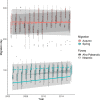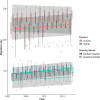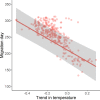Flyway-scale analysis reveals that the timing of migration in wading birds is becoming later
- PMID: 34707846
- PMCID: PMC8525091
- DOI: 10.1002/ece3.8130
Flyway-scale analysis reveals that the timing of migration in wading birds is becoming later
Abstract
Understanding the implications of climate change for migratory animals is paramount for establishing how best to conserve them. A large body of evidence suggests that birds are migrating earlier in response to rising temperatures, but many studies focus on single populations of model species.Migratory patterns at large spatial scales may differ from those occurring in single populations, for example because of individuals dispersing outside of study areas. Furthermore, understanding phenological trends across species is vital because we need a holistic understanding of how climate change affects wildlife, especially as rates of temperature change vary globally.The life cycles of migratory wading birds cover vast latitudinal gradients, making them particularly susceptible to climate change and, therefore, ideal model organisms for understanding its effects. Here, we implement a novel application of changepoint detection analysis to investigate changes in the timing of migration in waders at a flyway scale using a thirteen-year citizen science dataset (eBird) and determine the influence of changes in weather conditions on large-scale migratory patterns.In contrast to most previous research, our results suggest that migration is getting later in both spring and autumn. We show that rates of change were faster in spring than autumn in both the Afro-Palearctic and Nearctic flyways, but that weather conditions in autumn, not in spring, predicted temporal changes in the corresponding season. Birds migrated earlier in autumn when temperatures increased rapidly, and later with increasing headwinds.One possible explanation for our results is that migration is becoming later due to northward range shifts, which means that a higher proportion of birds travel greater distances and therefore take longer to reach their destinations. Our findings underline the importance of considering spatial scale when investigating changes in the phenology of migratory bird species.
Keywords: birds; climate change; continental scale; eBird; migration; phenology; waders; weather.
© 2021 The Authors. Ecology and Evolution published by John Wiley & Sons Ltd.
Conflict of interest statement
The authors have no conflict of interest to declare.
Figures






References
-
- Adamík, P. , & Pietruszková, J. (2008). Advances in spring but variable autumnal trends in timing of inland wader migration. Acta Ornithologica, 43(2), 119–128. 10.3161/000164508X395225 - DOI
-
- AEWA (2018). Report on the conservation status of migratory waterbirds in the agreement area. Retrieved from Durban, South Africa.
-
- Åkesson, S. , & Hedenström, A. (2000). Wind selectivity of migratory flight departures in birds. Behavioral Ecology and Sociobiology, 47(3), 140–144. 10.1007/s002650050004 - DOI
LinkOut - more resources
Full Text Sources

